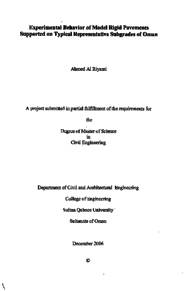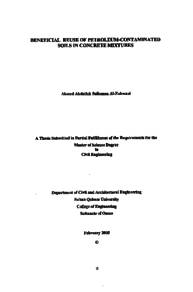وثيقة
Experimental behavior of model rigid pavements supported on typical representative subgrades of Oman
الناشر
Sultan Qaboos University
ميلادي
2006
اللغة
الأنجليزية
الملخص الإنجليزي
The main objective of this work is to study experimentally the behavior of
rigid pavements under different loading conditions using different types of soils
representing the local conditions in the Sultanate of Oman. The investigation
included the study of the deflection load transfer efficiency for different types of
joints.
The methodology and scope of work of this project included the study of the
properties of fine sand and coarse aggregate used in the subgrade material and the
properties of the concrete materials used in manufacturing the proposed slabs. The
experimental program of this work includes manufacturing and testing of six rigid
slab samples of size 900 x 1760 x 100 mm. Three types of joints were tested
including continuous (no joint), contraction joints, and contraction joints with
dowels. First, each sample was tested within the uncracked elastic stage using
different loading positions. After that, the sample was tested incrementally until
failure for the critical load position.
The results of this study indicate that the use of the joints in rigid slabs allows
transferring apart of the applied load to unloaded slab. In general, the joints used
have a significant reduction in deflection and strains. The performance of the
contraction joints with dowels was found better than the contraction joint in
transferring the load and reducing the deflections. The use of a fine sand subgrade
was found better in reducing the deflection of the rigid slabs at the time of loading.
المجموعة
URL المصدر
الملخص العربي
الهدف الرئيسي من هذا المشروع هو دراسة سلوك الأرصفة الأسمنتية بشكل تجريبي تحت حالات التحميل المختلفة واستعمال أنواع مختلفة من التربة التي تمثل الأنواع المحلية بسلطنة عمان. كما يدرس المشروع كفاءة المفاصل المستخدمة بين الأرصفة في إمكانية نقل وتحويل جزء من الأحمال المركزة على الأرصفة المحملة إلى الأرصفة الغير محملة.
اشتمل الأسلوب ومجال العمل لهذا المشروع على دراسة خصائص التربة التي استخدمت في تصنيع الأرصفة الترابية التي يرصف عليها الأرصفة الأسمنتية وهي الرمل الناعم والحصى وخصائص الخرسانة المصممة لتصنيع عينات الأرصفة الأسمنتية. كما اشتمل البرنامج التجريبي على تصنيع واختبار 6 عينات من الأرصفة الأسمنتية بمقاس 900مم x 1760مم وسمك 100مم. وتم استخدام ثلاث أنوع من المفاصل وهي بدون مفصل، مفصل انكماش ومفصل انكماش بالمسامير. وتم تزويد كل عيينتين بنوع واحد من المفاصل المذكورة. تم اختبار وتحميل كل عينة في المجال المرن في ثلاث أماكن ومن ثم تم تحميل كل عينة في المجال الغير مرن حتى درجة الفشل.
أوضحت الدراسة فاعلية المفاصل المستخدمة في تحويل جزء من الحمل المطبق على الرصيف المحمل إلى الرصيف الغير محمل. كما كان لها دور في تقليل الجهد والانحناء على الرصيف المحمل. تبين من خلال النتائج بأن مفصل الانكماش بالمسامير كان الأفضل من مفصل الانكماش بدون مسامير. تم الحصول على افضل كفاءة لنقل الحمل من العينات ذو مفصل الانكماش بالمسامير والمحملة على الأرصفة الترابية المكونة من الحصى. ووجد أيضا أن الرصيف الترابي المكون من الرمل الناعم كان الأفضل في تقليل الانحناء للأرصفة الأسمنتية أثناء التحميل.
اشتمل الأسلوب ومجال العمل لهذا المشروع على دراسة خصائص التربة التي استخدمت في تصنيع الأرصفة الترابية التي يرصف عليها الأرصفة الأسمنتية وهي الرمل الناعم والحصى وخصائص الخرسانة المصممة لتصنيع عينات الأرصفة الأسمنتية. كما اشتمل البرنامج التجريبي على تصنيع واختبار 6 عينات من الأرصفة الأسمنتية بمقاس 900مم x 1760مم وسمك 100مم. وتم استخدام ثلاث أنوع من المفاصل وهي بدون مفصل، مفصل انكماش ومفصل انكماش بالمسامير. وتم تزويد كل عيينتين بنوع واحد من المفاصل المذكورة. تم اختبار وتحميل كل عينة في المجال المرن في ثلاث أماكن ومن ثم تم تحميل كل عينة في المجال الغير مرن حتى درجة الفشل.
أوضحت الدراسة فاعلية المفاصل المستخدمة في تحويل جزء من الحمل المطبق على الرصيف المحمل إلى الرصيف الغير محمل. كما كان لها دور في تقليل الجهد والانحناء على الرصيف المحمل. تبين من خلال النتائج بأن مفصل الانكماش بالمسامير كان الأفضل من مفصل الانكماش بدون مسامير. تم الحصول على افضل كفاءة لنقل الحمل من العينات ذو مفصل الانكماش بالمسامير والمحملة على الأرصفة الترابية المكونة من الحصى. ووجد أيضا أن الرصيف الترابي المكون من الرمل الناعم كان الأفضل في تقليل الانحناء للأرصفة الأسمنتية أثناء التحميل.
قالب العنصر
الرسائل والأطروحات الجامعية


